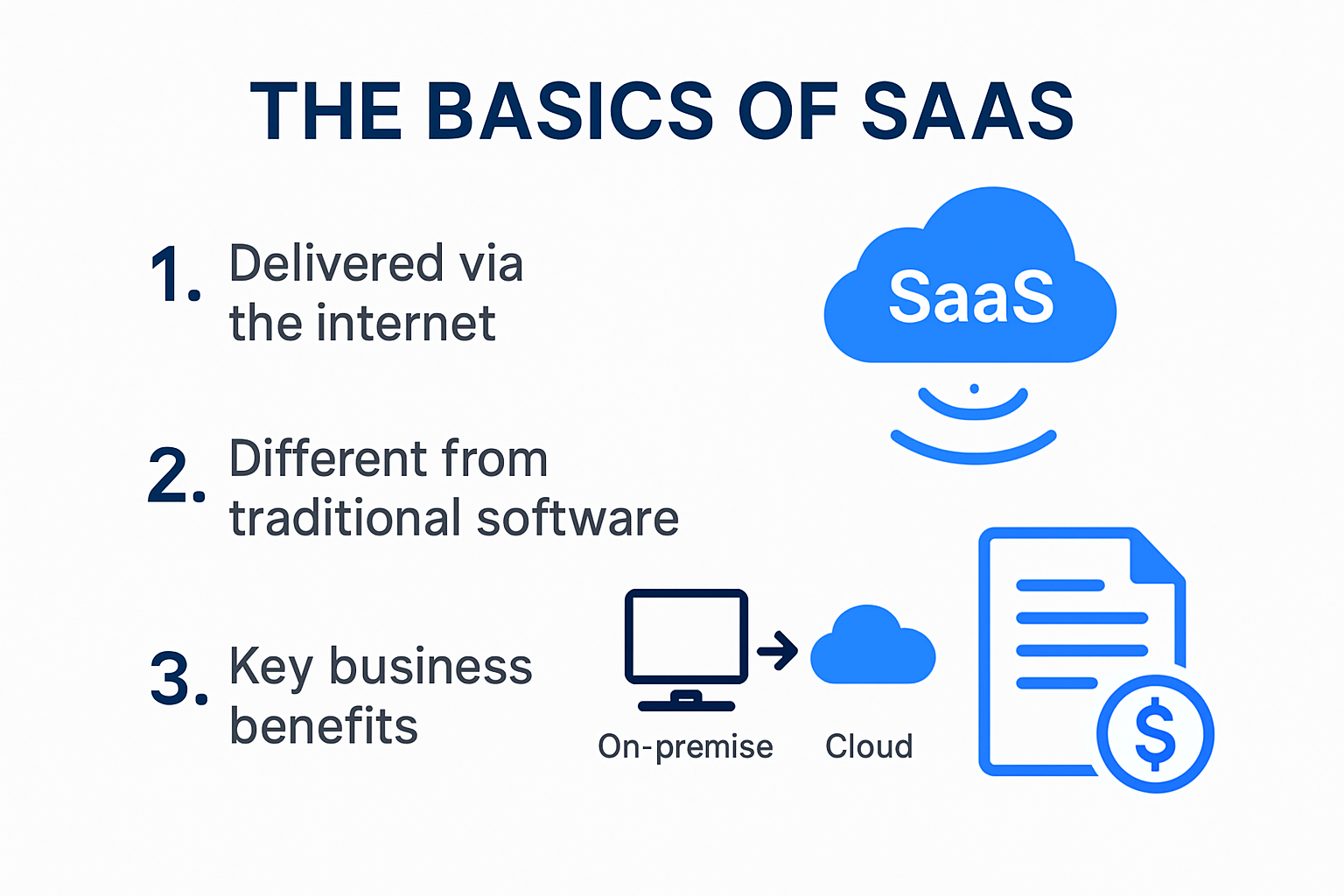What Does SaaS Mean? A Simple Guide for Modern Businesses (2025)
SaaS is taking over how companies use software. Firms are now saving up to 30% on IT costs just by switching to subscription-based cloud apps. At first, it sounds like SaaS is all about saving money and skipping the hassle of updates. But the real secret? SaaS opens the door for small businesses to use big-league tech that was once reserved only for huge corporations.
Table of Contents
- Explaining What SaaS Means For Companies
- How SaaS Works In Everyday Business
- Why SaaS Matters For Digital Transformation
- Key Benefits Of SaaS For Growing Businesses
Quick Summary
| Takeaway | Explanation |
|---|---|
| SaaS enhances scalability for businesses | Companies can quickly adjust software resources based on operational needs, promoting agility and competitiveness. |
| Cost savings with subscription models | SaaS reduces upfront costs and lowers overall IT spending by up to 30%, making budgeting easier. |
| Immediate access to updates and security | Businesses benefit from automatic updates and security patches, ensuring they operate with the latest features without resource drain. |
| Democratization of technology for all sizes | Small and medium-sized businesses can access advanced technologies that were previously only available to larger corporations. |
| Facilitates collaboration across locations | Teams can work together in real-time from diverse locations, enhancing productivity in remote and hybrid work environments. |
Explaining What SaaS Means for Companies
For modern businesses seeking efficient technological solutions, Software as a Service (SaaS) represents a transformative approach to software deployment and management. SaaS fundamentally changes how companies access, utilize, and manage digital tools , eliminating traditional barriers of complex software installation and maintenance.

The Core Mechanics of SaaS for Business Operations
At its essence, SaaS delivers software applications directly through the internet, functioning as a cloud-based service that companies can access on-demand. According to the National Institute of Standards and Technology (NIST) , SaaS removes the need for companies to install and maintain programs locally, streamlining IT management and security while keeping software consistently updated.
Businesses leveraging SaaS solutions benefit from several critical advantages. Scalability becomes inherent in these cloud-based models, allowing organizations to quickly adapt their software resources to changing operational needs. Companies can rapidly scale services up or down without significant infrastructure investments, making technological agility a competitive advantage.
To help visualize the core benefits of SaaS compared to traditional software models, below is a summary table outlining key differences discussed in this section.
| Feature/Benefit | SaaS (Cloud-Based) | Traditional Software (On-Premise) |
|---|---|---|
| Installation | Access via internet browser | Local installation required |
| Upgrades & Maintenance | Automatic, handled by provider | Manual, handled by in-house IT |
| Scalability | Rapid, on-demand | Requires hardware/software upgrades |
| Upfront Cost | Low (subscription-based) | High (license, hardware, IT setup) |
| Accessibility | Any device, any location | Limited to installed workstations |
| Security Updates | Frequent, automatic | Manual, may be infrequent |
Economic and Operational Benefits of SaaS Adoption
The economic implications of SaaS are particularly compelling for businesses of all sizes. Traditional software procurement involved substantial upfront costs for licensing, hardware, and ongoing maintenance. Research from Gartner indicates that SaaS models can reduce overall IT spending by up to 30% through subscription-based pricing and reduced infrastructure requirements.
Moreover, SaaS platforms provide automatic updates and security patches, eliminating the complex and time-consuming processes of manual software maintenance. This approach ensures that businesses always operate with the most recent features and robust security protocols without dedicating extensive internal resources to technical management.
Strategic Technology Integration
The strategic value of SaaS extends beyond immediate cost savings. By leveraging custom software solutions , businesses can integrate sophisticated technological capabilities that were previously accessible only to large enterprises with extensive IT budgets. Small and medium-sized businesses now have unprecedented access to advanced tools that can drive innovation, improve operational efficiency, and compete more effectively in digital marketplaces.
This democratization of technology through SaaS means companies can focus on their core competencies while relying on sophisticated, professionally managed software infrastructure. The model supports rapid digital transformation, enabling businesses to quickly adopt cutting-edge technologies without substantial capital investments or complex implementation processes.
How SaaS Works in Everyday Business
In the dynamic world of modern business, Software as a Service (SaaS) has become an integral mechanism for operational efficiency and technological flexibility. SaaS transforms how companies interact with digital tools , providing seamless, internet-powered solutions that fundamentally reshape traditional software consumption models.
Accessing and Deploying SaaS Applications
According to the National Institute of Standards and Technology , SaaS operates through a cloud computing model where applications are accessed directly via web browsers. This approach eliminates complex installation processes, allowing businesses to quickly implement sophisticated software solutions without significant technical infrastructure.
Typical SaaS deployment involves simple steps: selecting a subscription plan, creating user accounts, and accessing the platform through secure login credentials. Companies can rapidly onboard teams, configure permissions, and start utilizing advanced tools within minutes. Accessibility becomes a core advantage, enabling employees to work from diverse locations using various devices.
Below is a step-by-step table summarizing the typical process for accessing and deploying SaaS applications in a business:
| Step | Action | Description |
|---|---|---|
| 1 | Select subscription plan | Choose the SaaS package that fits company size and needs |
| 2 | Create user accounts | Register users and set up system access |
| 3 | Configure permissions | Assign roles and permissions for users |
| 4 | Access via web browser | Log in securely from any authorized device |
| 5 | Begin using the platform | Start leveraging SaaS tools for business operations |
Practical Business Workflow Integration

Research published in the National Center for Biotechnology Information highlights how SaaS supports remote work and collaboration by offering flexible, real-time access to applications. Modern businesses leverage SaaS across multiple operational domains such as customer relationship management, project tracking, financial reporting, and human resources management.
For instance, a marketing team might use a SaaS platform for campaign management, simultaneously accessing shared dashboards, generating reports, and collaborating on strategies. Sales teams can track customer interactions through cloud-based CRM systems, while finance departments utilize online accounting software for real-time financial monitoring.
Security and Continuous Updates
One of the most significant advantages of SaaS is the robust security and automatic update mechanisms. Learn more about custom software solutions that can enhance your business technology strategy. SaaS providers continuously monitor and patch security vulnerabilities, ensuring that businesses always operate with the most current and secure software versions.
This model transfers the complex responsibilities of maintenance, security, and upgrades from individual companies to specialized technology providers. Businesses no longer need extensive IT teams to manage software infrastructure, allowing them to focus on core operational objectives. The subscription-based pricing further simplifies budgeting, providing predictable technology expenses and eliminating large upfront investments in software and hardware.
By embracing SaaS, companies gain unprecedented technological agility. The model supports rapid scaling, reduces operational complexity, and provides access to cutting-edge tools that were previously accessible only to large enterprises with substantial IT budgets.
Why SaaS Matters for Digital Transformation
Digital transformation has become a critical strategic imperative for businesses seeking to remain competitive in an increasingly technology-driven marketplace. SaaS plays a pivotal role in enabling organizations to accelerate their digital evolution , providing powerful tools that reshape traditional business models and operational approaches.
Democratizing Advanced Technology
According to research from McKinsey Digital , SaaS solutions have fundamentally democratized access to sophisticated technological capabilities. Previously, advanced software tools were exclusively available to large enterprises with substantial IT budgets. Now, small and medium-sized businesses can leverage enterprise-grade technologies through flexible, subscription-based models.
This technological democratization means companies of all sizes can implement cutting-edge solutions without massive upfront investments. Artificial intelligence, machine learning, advanced analytics, and comprehensive collaboration tools are now within reach for organizations that would have been excluded from such technologies just a decade ago.
Enabling Rapid Organizational Adaptation
Research from Deloitte highlights how SaaS platforms provide businesses with unprecedented agility in responding to market changes. The cloud-based nature of these solutions allows companies to quickly scale resources, integrate new functionalities, and pivot their technological infrastructure with minimal disruption.
Businesses can now test new strategies, launch innovative services, and experiment with digital products without committing to extensive infrastructure development. Explore our approach to custom software solutions that can accelerate your digital transformation journey. This flexibility is crucial in an era of rapid technological change and unpredictable market dynamics.
Strategic Innovation and Competitive Advantage
SaaS goes beyond mere technological implementation. It represents a strategic approach to business innovation that allows companies to focus on core competencies while leveraging advanced technological capabilities. By outsourcing complex software management to specialized providers, organizations can redirect resources toward strategic initiatives, product development, and customer experience enhancement.
The continuous update mechanisms inherent in SaaS models ensure that businesses always have access to the latest features and security protocols. This means companies can stay technologically current without dedicating extensive internal resources to software maintenance and upgrades.
Moreover, SaaS solutions facilitate better data integration and analytics, enabling more informed decision-making. Companies can gain real-time insights into their operations, customer behaviors, and market trends, transforming raw data into actionable strategic intelligence.
Ultimately, SaaS is not just a technological tool but a strategic enabler of digital transformation. It provides businesses with the flexibility, accessibility, and innovative potential needed to thrive in an increasingly digital global economy. By embracing SaaS, organizations can build more resilient, adaptive, and forward-thinking business models that are prepared for future technological challenges and opportunities.
Key Benefits of SaaS for Growing Businesses
For growing businesses navigating an increasingly complex technological landscape, Software as a Service (SaaS) offers a transformative approach to operational efficiency and strategic growth. SaaS provides a robust technological framework that empowers organizations to optimize resources, enhance productivity, and compete more effectively in dynamic market environments.
Accelerated Business Deployment and Scalability
According to research from Salesforce , SaaS enables businesses to get started 70% faster than traditional on-premise software solutions. This rapid deployment means companies can quickly implement sophisticated technological tools without extensive setup times or significant infrastructure investments.
The scalability of SaaS platforms allows businesses to adjust their technological resources precisely to their current needs. Growing organizations can seamlessly expand or contract their software subscriptions, ensuring they only pay for the exact capabilities required at any given moment. This flexibility is particularly crucial for startups and small to medium-sized businesses that experience fluctuating operational demands.
The table below summarizes the key benefits of SaaS for growing businesses, as discussed throughout this section:
| Key Benefit | Description |
|---|---|
| Rapid Deployment | Businesses can launch software solutions up to 70% faster than on-premise alternatives |
| Scalability | Expand or reduce resources based on current business needs without major investment |
| Low Upfront Costs | Avoid large capital expenditures and pay a predictable monthly subscription |
| Minimal Maintenance | Automatic updates and cloud-based management handled by SaaS provider |
| Enhanced Collaboration | Teams work together in real-time across locations and devices |
| Technological Accessibility | Access advanced technology previously limited to large enterprises |
| Supports Remote/Hybrid Work | Employees can access business tools from anywhere with internet connectivity |
Cost-Effective Technology Management
According to digital government resources , SaaS provides minimal maintenance requirements through automatic updates and cloud-based infrastructure. Businesses can eliminate substantial upfront hardware and software costs, transforming complex technological investments into predictable, manageable monthly subscriptions.
The economic advantages extend beyond direct software expenses. By outsourcing complex technical maintenance to specialized providers, companies can redirect internal resources toward core business strategies. Learn about optimizing your software development approach to maximize these technological investments.
Enhanced Collaboration and Technological Accessibility
Modern SaaS platforms are designed to facilitate seamless collaboration across diverse geographical locations. Teams can access identical software interfaces, share real-time data, and collaborate efficiently regardless of physical distance. This capability becomes increasingly important in an era of distributed and remote work environments.
Research indicates that 91% of organizations believe SaaS will help them adopt new technologies and drive revenue growth. The cloud-based nature of these solutions ensures that employees can access critical business tools from any device with an internet connection, promoting flexibility and maintaining productivity across various work scenarios.
By embracing SaaS, growing businesses gain more than just technological tools. They acquire a strategic approach to digital transformation that provides agility, cost-efficiency, and competitive advantage. The ability to rapidly deploy, scale, and adapt technological resources positions organizations to respond quickly to market changes and emerging opportunities.
Frequently Asked Questions
What does SaaS stand for?
SaaS stands for Software as a Service, which is a cloud-based software delivery model that allows companies to access applications via the internet.
How does SaaS benefit businesses?
SaaS offers several benefits, including reduced IT costs, automatic updates, scalability, and the ability for teams to collaborate from anywhere, facilitating increased operational efficiency.
Is SaaS cost-effective for small businesses?
Yes, SaaS is cost-effective for small businesses, as it typically involves lower upfront costs through subscription models, reducing the overall IT spending by up to 30% compared to traditional software.
How does SaaS support digital transformation?
SaaS supports digital transformation by democratizing access to advanced technologies, enabling rapid organizational adaptation, and allowing businesses to focus on core competencies while leveraging sophisticated software solutions.
Ready to Turn SaaS Potential Into Real Business Growth?
Are you wondering how shifting to SaaS can actually help your company grow, save costs, and do more with less? The article explained how SaaS streamlines technology, boosts scalability, and breaks down IT barriers for growing businesses. You may still feel unsure about how to apply these benefits to your unique workflow or how to integrate SaaS tools with your existing systems. Many business leaders struggle to align fast-changing digital solutions with their company’s goals or find it overwhelming to customize what they really need.
Let our digital experts show you what your business can achieve. 
Get started on your digital transformation with TRAVLRD’s custom software solutions . We help you build the right foundations, whether you need a branded SaaS product, a powerful web application, or seamless integrations that reduce your costs and maximize team results. See our full suite of digital services and book your free consultation today. Let us help you unlock modern technology with confidence, speed, and creativity.







